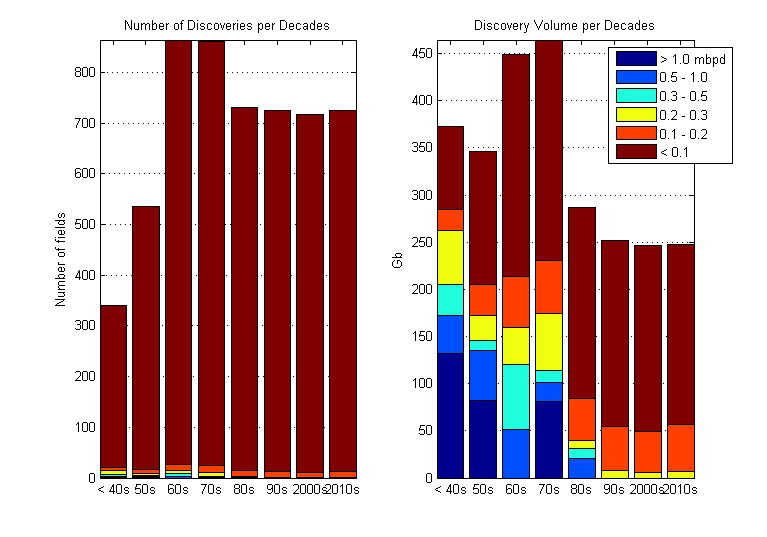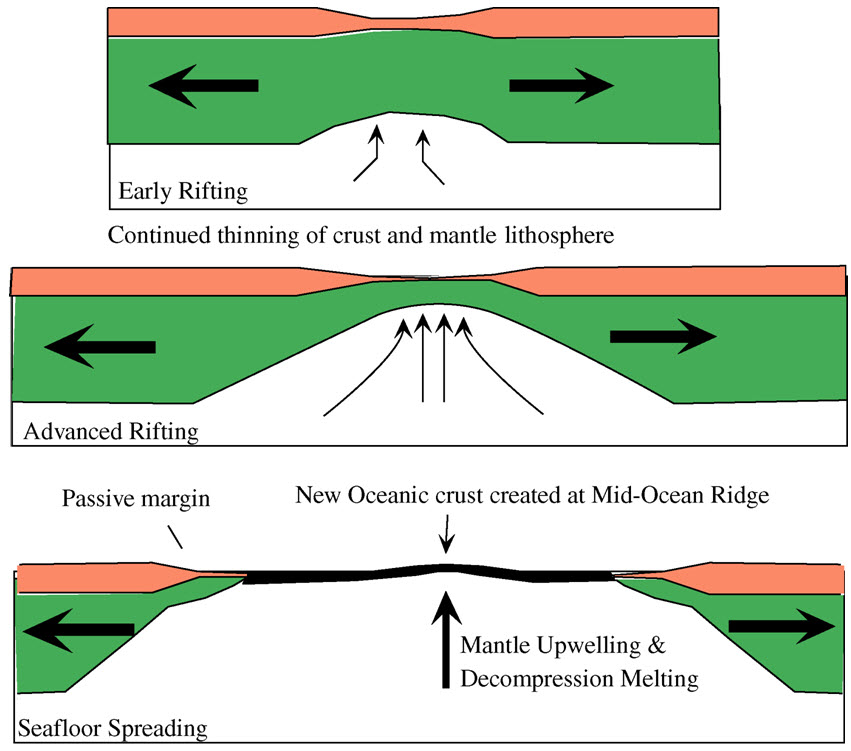|
Giant Oil And Gas Fields
The world's 932 giant oil and gas fields are considered those with of ultimately recoverable oil or gas equivalent. Geoscientists believe these giants account for 40 percent of the world's petroleum reserves. They are clustered in 27 regions of the world, with the largest clusters in the Persian Gulf and Western Siberian basin. The past three decades reflect declines in discoveries of giant fields. The years 2000–11 reflect an upturn in discoveries and appears on track to be the third best decade for discovery of giant oil and gas fields in the 150-year history of modern oil and gas exploration. Recent work in tracking giant oil and gas fields follows the earlier efforts of the late exploration geologist Michel T. Halbouty, who tracked trends in giant discoveries from the 1960s to 2004. Tectonic settings Geophysicists and exploration geologists who look for oil and gas fields classify the subsurface characteristics, or tectonic setting, of geological structures that con ... [...More Info...] [...Related Items...] OR: [Wikipedia] [Google] [Baidu] |
Antarctica
Antarctica () is Earth's southernmost and least-populated continent. Situated almost entirely south of the Antarctic Circle and surrounded by the Southern Ocean (also known as the Antarctic Ocean), it contains the geographic South Pole. Antarctica is the fifth-largest continent, being about 40% larger than Europe, and has an area of . Most of Antarctica is covered by the Antarctic ice sheet, with an average thickness of . Antarctica is, on average, the coldest, driest, and windiest of the continents, and it has the highest average elevation. It is mainly a polar desert, with annual Climate of Antarctica#Precipitation, precipitation of over along the coast and far less inland. About 70% of the world's freshwater reserves are frozen in Antarctica, which, if melted, would raise global sea levels by almost . Antarctica holds the record for the Lowest temperature recorded on Earth, lowest measured temperature on Earth, . The coastal regions can reach temperatures over in the ... [...More Info...] [...Related Items...] OR: [Wikipedia] [Google] [Baidu] |
Peak Oil
Peak oil is the point when global oil production reaches its maximum rate, after which it will begin to decline irreversibly. The main concern is that global transportation relies heavily on gasoline and diesel. Adoption of electric vehicles, biofuels, or more efficient transport (like trains and waterways) could help reduce oil demand. Peak oil relates closely to oil depletion; while petroleum reserves are finite, the key issue is the economic viability of extraction at current prices. Initially, it was believed that oil production would decline due to reserve depletion, but a new theory suggests that reduced oil demand could lower prices, affecting extraction costs. Demand may also decline due to persistent high prices. Over the last century, many predictions of peak oil timing have been made, often later proven incorrect due to increased extraction rates. M. King Hubbert introduced the concept in a 1956 paper, predicting U.S. production would peak between 1965 and 1 ... [...More Info...] [...Related Items...] OR: [Wikipedia] [Google] [Baidu] |
Oil Megaprojects
Oil megaprojects are large oil field A petroleum reservoir or oil and gas reservoir is a subsurface accumulation of hydrocarbons contained in porous or fractured rock formations. Such reservoirs form when kerogen (ancient plant matter) is created in surrounding rock by the prese ... projects. Summary of megaprojects Definition of megaproject: 20,000 barrels per day (3,200 m3/d) of new liquid fuel capacity. Megaprojects predicted for individual years Application to oil supply forecasting A series of project tabulations and analyses by Chris Skrebowski, editor of ''Petroleum Review'', have presented a more pessimistic picture of future oil supply. In a 2004 report, based on an analysis of new projects over , he argued that although ample supply might be available in the near-term, after 2007 "the volumes of new production for this period are well below likely requirements." By 2006, although "the outlook for future supply appears somewhat brighter than even six months ag ... [...More Info...] [...Related Items...] OR: [Wikipedia] [Google] [Baidu] |
List Of Oil Fields
This list of oil fields includes some Giant oil and gas fields, major oil fields of the past and present. The list is incomplete; there are more than 25,000 petroleum, oil and natural gas, gas Petroleum reservoir#gas field, fields of all sizes in the world. However, 94% of known oil is concentrated in fewer than 1,500 giant and major fields.Ivanhoe, L.F, and G.G. Leckie. "Global oil, gas fields, sizes tallied, analyzed," ''Oil and Gas Journal''. Feb. 1 , 0001, pp. 87–91 Most of the world's largest oilfields are located in the Middle East, but there are also supergiant (>10 billion Barrel (unit), bbls) oilfields in Brazil, Mexico, Venezuela, Kazakhstan, and Russia. Amounts listed below, in billions of barrels, are the estimated ultimate recoverable petroleum resources (proved reserves plus cumulative production), given historical production and current extraction technology. Oil shale reserves (perhaps ) and coal reserves, both of which can be converted to liquid petroleum, are ... [...More Info...] [...Related Items...] OR: [Wikipedia] [Google] [Baidu] |
List Of Natural Gas Fields
This list of natural gas fields includes major fields of the past and present. N.B. Some of the items listed are basins or projects that comprise many fields (e.g. Sakhalin has three fields: Chayvo, Odoptu, and Arkutun-Dagi). 25 largest conventional non-associated gas fields ''Table sources:'' Data was retrieved from, depletion levels from or calculated from open source production data. Notes: *Gasfields are non-associated gas and condensate fields. *Size refers to ultimate recoverable reserves (including past production) expressed in trillion cubic feet. By location ; Algeria * Hassi R'mel () ; Australia * Bass Strait * Jansz () * Greater Gorgon () * Browse Venture ( * North West Shelf Venture () * Yolla gas field * Fairview, Scotia, Spring Gully, Bowen Basin ; Azerbaijan * Shah Deniz gas field () ; Bahrain * Awali () ; Bolivia (~1.5 trillion m3) * Margarita * Sabalo * Itaú-San Alberto ; Brazil * Albacora-Leste oil field () * Jupiter gas field (17 x ... [...More Info...] [...Related Items...] OR: [Wikipedia] [Google] [Baidu] |
List Of Countries By Proven Oil Reserves
Oil reserves, Proven oil reserves are those quantities of petroleum which, by analysis of geological and engineering data, can be estimated, with a high degree of confidence, to be commercially recoverable from a given date forward from known reservoirs and under current economic conditions. Some statistics on this page are disputed and controversial—different sources (OPEC, ''The World Factbook, CIA World Factbook'', list of oil exploration and production companies, oil companies) give different figures. Some of the differences reflect different types of oil included. Different estimates may or may not include oil shale, mined oil sands or Natural-gas processing#Contaminants in raw natural gas, natural gas liquids. Because proven reserves include oil recoverable under current economic conditions, nations may see large increases in proven reserves when known, but previously uneconomic deposits become economic to develop. In this way, Canada's proven reserves increased sudden ... [...More Info...] [...Related Items...] OR: [Wikipedia] [Google] [Baidu] |
Hydrocarbon Exploration
Hydrocarbon exploration (or oil and gas exploration) is the search by petroleum geologists and geophysicists for hydrocarbon deposits, particularly petroleum and natural gas, in the Earth's crust using petroleum geology. Exploration methods Visible surface features such as oil seeps, natural gas seeps, pockmarks (underwater craters caused by escaping gas) provide basic evidence of hydrocarbon generation (be it shallow or deep in the Earth). However, most exploration depends on highly sophisticated technology to detect and determine the extent of these deposits using exploration geophysics. Areas thought to contain hydrocarbons are initially subjected to a gravity survey, magnetic survey, passive seismic or regional seismic reflection surveys to detect large-scale features of the sub-surface geology. Features of interest (known as ''leads'') are subjected to more detailed seismic surveys which work on the principle of the time it takes for reflected sound waves to travel ... [...More Info...] [...Related Items...] OR: [Wikipedia] [Google] [Baidu] |
Cantarell Field
Cantarell Field or Cantarell Complex is an aging supergiant offshore oil field in Mexico. It was discovered in 1976 after oil stains were noticed by a fisherman, Rudesindo Cantarell Jimenez, in 1972. It was placed on nitrogen injection in 2000, and production peaked at in 2004. In terms of cumulative production to date, it was the largest oil field in Mexico, and one of the largest in the world. However, production has declined since 2004, falling to in 2022. In 2009 it was superseded by Ku-Maloob-Zaap as Mexico's largest oil field. Location Cantarell is located offshore in the Bay of Campeche. This complex comprises four major fields: Akal (by far the largest), Nohoch, Chac and Kutz. The reservoirs are formed from carbonate breccia of Late Cretaceous age, the rubble from the asteroid impact that created the Chicxulub Crater. The recently discovered Sihil field (1-15,000 million barrels) contains light oil in Jurassic strata below the other reservoirs and is generally ... [...More Info...] [...Related Items...] OR: [Wikipedia] [Google] [Baidu] |
Arctic
The Arctic (; . ) is the polar regions of Earth, polar region of Earth that surrounds the North Pole, lying within the Arctic Circle. The Arctic region, from the IERS Reference Meridian travelling east, consists of parts of northern Norway (Nordland, Troms, Finnmark, Svalbard and Jan Mayen), northernmost Sweden (Västerbotten, Norrbotten and Lapland (Sweden), Lappland), northern Finland (North Ostrobothnia, Kainuu and Lapland (Finland), Lappi), Russia (Murmansk Oblast, Murmansk, Siberia, Nenets Autonomous Okrug, Nenets Okrug, Novaya Zemlya), the United States (Alaska), Canada (Yukon, Northwest Territories, Nunavut), Danish Realm (Greenland), and northern Iceland (Grímsey and Kolbeinsey), along with the Arctic Ocean and adjacent seas. Land within the Arctic region has seasonally varying cryosphere, snow and ice cover, with predominantly treeless permafrost under the tundra. Arctic seas contain seasonal sea ice in many places. The Arctic region is a unique area among Earth's ... [...More Info...] [...Related Items...] OR: [Wikipedia] [Google] [Baidu] |
Passive Margin
A passive margin is the transition between Lithosphere#Oceanic lithosphere, oceanic and Lithosphere#Continental lithosphere, continental lithosphere that is not an active plate continental margin, margin. A passive margin forms by sedimentation above an ancient rift, now marked by transitional lithosphere. Continental rifting forms new ocean basins. Eventually the continental rift forms a mid-ocean ridge and the locus of extensional tectonics, extension moves away from the continent-ocean boundary. The transition between the continental and oceanic lithosphere that was originally formed by rifting is known as a passive margin. Global distribution Passive margins are found at every ocean and continent boundary that is not marked by a Fault (geology)#Strike-slip faults, strike-slip fault or a subduction, subduction zone. Passive margins define the region around the Arctic Ocean, Atlantic Ocean, and western Indian Ocean, and define the entire coasts of Africa, Australia, Greenla ... [...More Info...] [...Related Items...] OR: [Wikipedia] [Google] [Baidu] |
Petroleum Reservoir
A petroleum reservoir or oil and gas reservoir is a subsurface accumulation of hydrocarbons contained in porous or fractured rock formations. Such reservoirs form when kerogen (ancient plant matter) is created in surrounding rock by the presence of high heat and pressure in the Earth's crust. Reservoirs are broadly classified as ''conventional'' and '' unconventional'' reservoirs. In conventional reservoirs, the naturally occurring hydrocarbons, such as crude oil (petroleum) or natural gas, are trapped by overlying rock formations with lower permeability, while in unconventional reservoirs the rocks have high porosity and low permeability, which keeps the hydrocarbons trapped in place, therefore not requiring a cap rock. Reservoirs are found using hydrocarbon exploration methods. Oil field An oil field is an area of accumulated liquid petroleum underground in multiple (potentially linked) reservoirs, trapped as it rises to impermeable rock formations. In industrial te ... [...More Info...] [...Related Items...] OR: [Wikipedia] [Google] [Baidu] |




